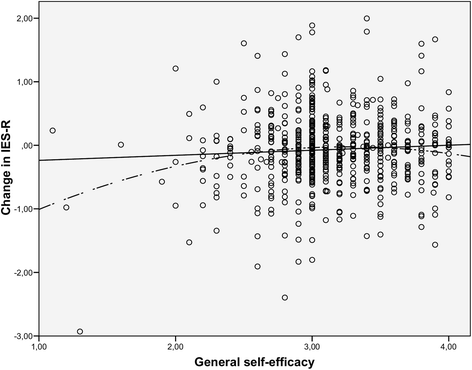General self-efficacy and posttraumatic stress after a natural disaster: a longitudinal study
- PMID: 27048603
- PMCID: PMC4822288
- DOI: 10.1186/s40359-016-0119-2
General self-efficacy and posttraumatic stress after a natural disaster: a longitudinal study
Abstract
Background: Self-efficacy may be an important factor in individuals' recovery from posttraumatic stress reactions after a natural disaster. However, few longitudinal studies have investigated whether self-efficacy predicts the course of posttraumatic recovery beyond lower initial levels of distress. The purpose of the present study was to investigate whether general self-efficacy is related to recovery from posttraumatic stress reactions from a longitudinal perspective.
Methods: A total of 617 Norwegians exposed to the 2004 Southeast Asian tsunami completed self-report questionnaires measuring their level of disaster exposure and general self-efficacy at 6 months and posttraumatic stress reactions 6 months and 2 years post-disaster. Predictors of changes in posttraumatic stress reactions were analyzed with multivariate mixed effects models.
Results: Self-efficacy at 6 months post-disaster was unrelated to trauma exposure and inversely related to posttraumatic stress reactions at 6 months and 2 years post-disaster. However, self-efficacy was not related to recovery from posttraumatic stress reactions between 6 months and 2 years post-disaster.
Conclusions: In conclusion, general self-efficacy is related to lower levels of posttraumatic stress reactions in the first months after a disaster but does not appear to be related to improved recovery rates over the longer term.
Keywords: Disaster; PTSD; Posttraumatic stress reactions; Self-efficacy.
Figures
Similar articles
-
Posttraumatic growth, depression and posttraumatic stress in relation to quality of life in tsunami survivors: a longitudinal study.Health Qual Life Outcomes. 2015 Feb 7;13:18. doi: 10.1186/s12955-014-0202-4. Health Qual Life Outcomes. 2015. PMID: 25889940 Free PMC article.
-
Children's and parents' posttraumatic stress reactions after the 2004 tsunami.Clin Child Psychol Psychiatry. 2011 Oct;16(4):621-34. doi: 10.1177/1359104510391048. Epub 2011 May 12. Clin Child Psychol Psychiatry. 2011. PMID: 21565871
-
Posttraumatic stress and symptom improvement in Norwegian tourists exposed to the 2004 tsunami--a longitudinal study.BMC Psychiatry. 2013 Sep 24;13:232. doi: 10.1186/1471-244X-13-232. BMC Psychiatry. 2013. PMID: 24063414 Free PMC article.
-
[Posttraumatic stress disorder (PTSD) as a consequence of the interaction between an individual genetic susceptibility, a traumatogenic event and a social context].Encephale. 2012 Oct;38(5):373-80. doi: 10.1016/j.encep.2011.12.003. Epub 2012 Jan 24. Encephale. 2012. PMID: 23062450 Review. French.
-
Children's disaster reactions: the influence of exposure and personal characteristics.Curr Psychiatry Rep. 2015 Jul;17(7):56. doi: 10.1007/s11920-015-0598-5. Curr Psychiatry Rep. 2015. PMID: 25980513 Review.
Cited by
-
Lenticular nucleus correlates of general self-efficacy in young adults.Brain Struct Funct. 2017 Sep;222(7):3309-3318. doi: 10.1007/s00429-017-1406-2. Epub 2017 Mar 28. Brain Struct Funct. 2017. PMID: 28353199 Free PMC article.
-
Longitudinal Relationship between Self-efficacy and Posttraumatic Stress Symptoms 8 Years after a Violent Assault: An Autoregressive Cross-Lagged Model.Front Psychol. 2017 Jun 1;8:913. doi: 10.3389/fpsyg.2017.00913. eCollection 2017. Front Psychol. 2017. PMID: 28620334 Free PMC article.
-
Validity and reliability of the Chinese version of human-robot interaction self-efficacy scale in Chinese adults.Psicol Reflex Crit. 2024 Sep 26;37(1):40. doi: 10.1186/s41155-024-00324-z. Psicol Reflex Crit. 2024. PMID: 39325246 Free PMC article.
-
A preliminary study investigating the neglected domain of mental health in Australian lifesavers and lifeguards.BMC Public Health. 2023 May 31;23(1):1036. doi: 10.1186/s12889-023-15741-5. BMC Public Health. 2023. PMID: 37259042 Free PMC article.
-
Mental health burden following extreme weather events in South-east Asia: A systematic review and meta-analysis.Indian J Psychiatry. 2024 Aug;66(8):683-694. doi: 10.4103/indianjpsychiatry.indianjpsychiatry_348_24. Epub 2024 Aug 19. Indian J Psychiatry. 2024. PMID: 39398512 Free PMC article.
References
-
- Bandura A. Social foundations of thought and action: a social cognitive theory. Englewood Cliffs: Prentice Hall; 1986.
Publication types
MeSH terms
LinkOut - more resources
Full Text Sources
Other Literature Sources
Medical


